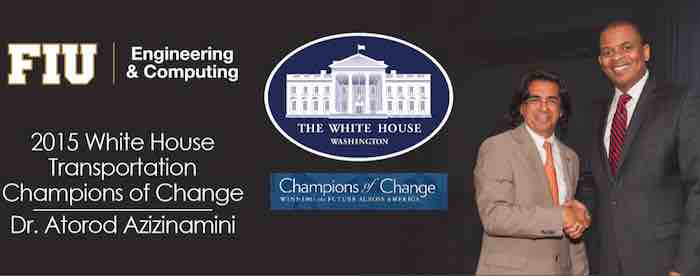By Judi McLeod ——Bio and Archives--March 16, 2018
Cover Story | CFP Comments | Reader Friendly | Subscribe | Email Us
 Celebrated leading visionary bridge engineer Atorod Azizinamini, whose ABC (Accelerated Bridge Construction) technology was used to build the bridge that collapsed yesterday on Florida International University's campus, was named an Obama era Department of Transportation 'Champion of Change' in 2015.
The event in which Azizinamini was awarded 'Champion of Change' status was webcast live at whitehouse.gov/live, no longer online.
Much will be made in coming days that FIGG Bridge Group designed the bridge and that it was constructed by MCM Construction, in the aftermath of the bridge's collapse.
Celebrated leading visionary bridge engineer Atorod Azizinamini, whose ABC (Accelerated Bridge Construction) technology was used to build the bridge that collapsed yesterday on Florida International University's campus, was named an Obama era Department of Transportation 'Champion of Change' in 2015.
The event in which Azizinamini was awarded 'Champion of Change' status was webcast live at whitehouse.gov/live, no longer online.
Much will be made in coming days that FIGG Bridge Group designed the bridge and that it was constructed by MCM Construction, in the aftermath of the bridge's collapse."Florida Senator Marco Rubio described the incident as "troubling and tragic," adding that it affects him personally because he has been an adjunct professor for the university for 10 years. (ABC News) "Ironically, it's a project for safety" that was constructed after a student died last year crossing that intersection, Rubio said during an evening press conference."But Rubio would certainly have been aware that the collapsed Florida International University Bridge was designed and built using a technique the university has been promoting for the last eight years.
Support Canada Free Press

"The idea took root at FIU in 2010, when the university hosted a meeting of bridge engineering professionals. FIU provided $50,000 in seed funding for the Center for Accelerated Bridge Construction, which launched in 2011. It started conducting monthly webinars on the construction method.The seed funding was soon to blossom into multi-millions of dollars over time: "The U.S. Department of Transportation awarded the Accelerated Bridge Construction University Transportation Center at FIU a $7.5 million, five-year grant in 2016 to advance the construction method. FIU was the lead institution, also working with partners Iowa State University, University of Nevada - Reno, University of Oklahoma, and University of Washington. (FIU News, Dec. 5, 2016) But the Accelerated Bridge Construction University Transportation at FIU really took wing through former President Barack Obama's economic stimulus: "The pedestrian bridge that collapsed at Florida International University's Miami-Dade campus today, killing several people, was funded with $11.4 million from the U.S. Department of Transportation's Transportation Investments Generating Economic Recovery (TIGER) program. The TIGER program has come under repeated fire for awarding money based on politics rather than merit. (Reason.com)
reason.com reports that in 2013, the FIU was awarded $11.4 million in TIGER money for its University City Prosperity Project, which included the pedestrian bridge. Some 52 projects were awarded $458 million in that round of TIGER grants--known as TIGER V--using methodology that was later criticized by the Government Accountability Office (GAO) for violating DOT's own standards. "DOT staff are tasked with evaluating all applications to the TIGER program for how closely they adhere to several "desired long-term transportation outcomes," including economic competitiveness, state of good repair, livability, environmental sustainability, and safety. Each project is assigned a rating that ranges from acceptable to highly recommended. "In 2014, the GAO released a report that was highly critical of how DOT handled the TIGER V grants, which included money for the FIU pedestrian bridge project. The report said DOT advanced projects with lower technical ratings in lieu of those with higher technical ratings and upgraded the technical rating of 19 projects from acceptable or recommended to highly recommended without documenting a justification. It is unclear from the GAO report whether the FIU bridge project was advanced over more qualified projects or if its technical rating was subsequently upgraded, since the report does not give project-by-project detail. "TIGER, which Reason has covered here, here and here, was created as an economic stimulus measure under President Barack Obama and morphed into a permanent program. It has awarded $5.6 billion in nine rounds of grants since 2009.

"A 2012 report from the Reason Foundation, which publishes this website, found that 40 percent of the grants in the first two TIGER rounds went to districts represented by Republicans on the House Transportation and Infrastructure Committee. The four highest-ranking Democrats on the same committee each received at least one TIGER grant. "Members of Florida's congressional delegation publicly lauded the TIGER award to FIU. "Thanks to this TIGER funding, FIU students will be able to walk from their student housing to class through a pedestrian bridge across Southwest Eighth Street," Rep. Debbie Wasserman-Schultz (D-Fla.) said in 2013. "More jobs will be created in our community thanks to this grant, and I look forward to celebrating the project's success with everyone in South Florida." "Rep. Mario Diaz-Balart (R–Fla.) made similar comments on Saturday. "FIU has come a long way since the TIGER grant that funded this pedestrian bridge was awarded in 2013," he said. "This project represents a true collaboration among so many different partners at local, state, and federal levels, and in both the public and private sectors."
"The bridge was the largest pedestrian span in the U.S. moved via self-propelled modular transportation, according to FIU. (BizJournals)Touted with Titanic-like boasts, it was said to be the first pedestrian bridge constructed entirely of self-cleaning concrete, which uses titanium dioxide in the concrete to capture pollution and keep the structure white. The bridge was supposed to last for more than 100 years and withstand a Category 5 hurricane. Instead it came crashing down on people occupied cars within days of its construction.
View Comments